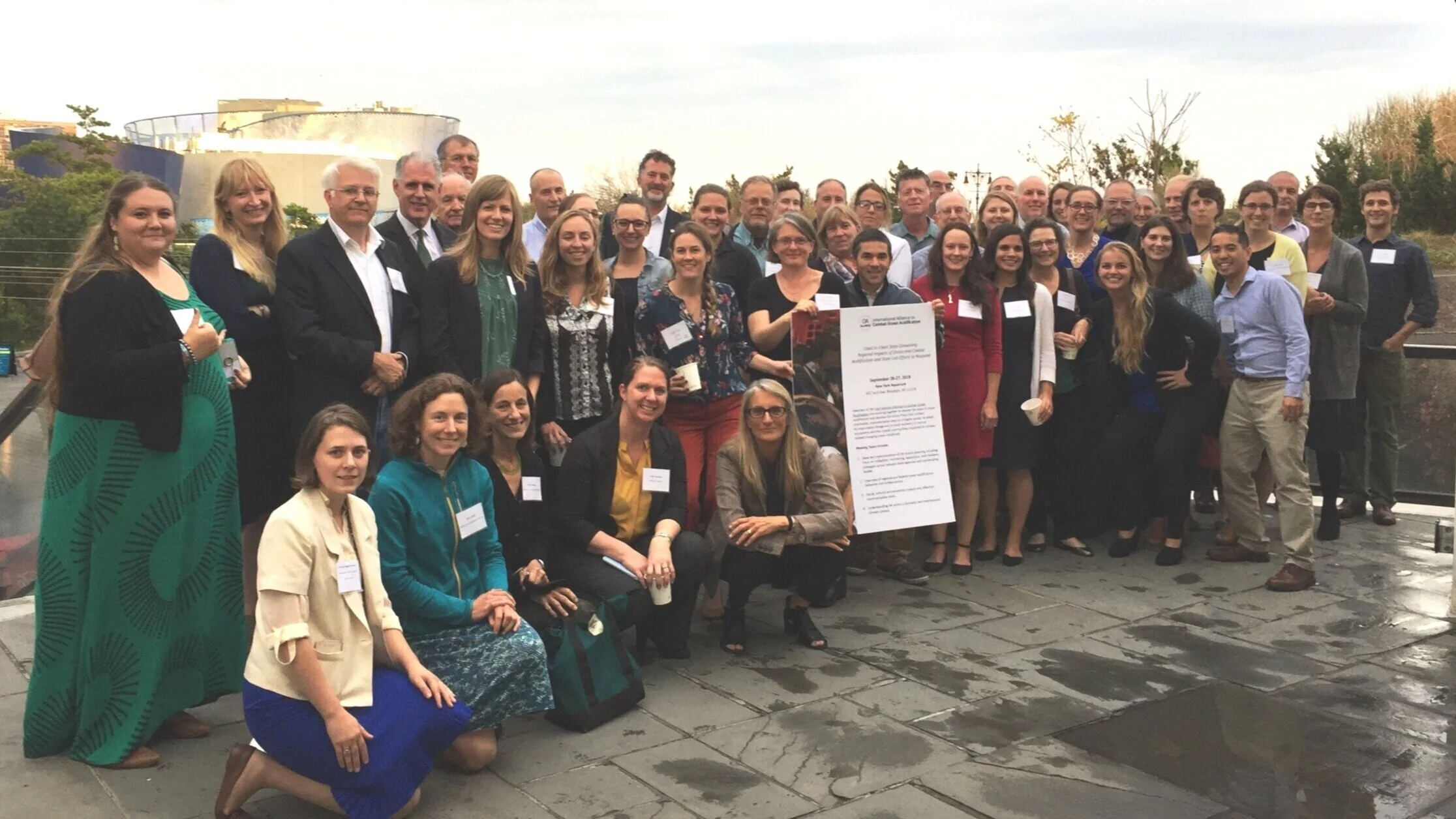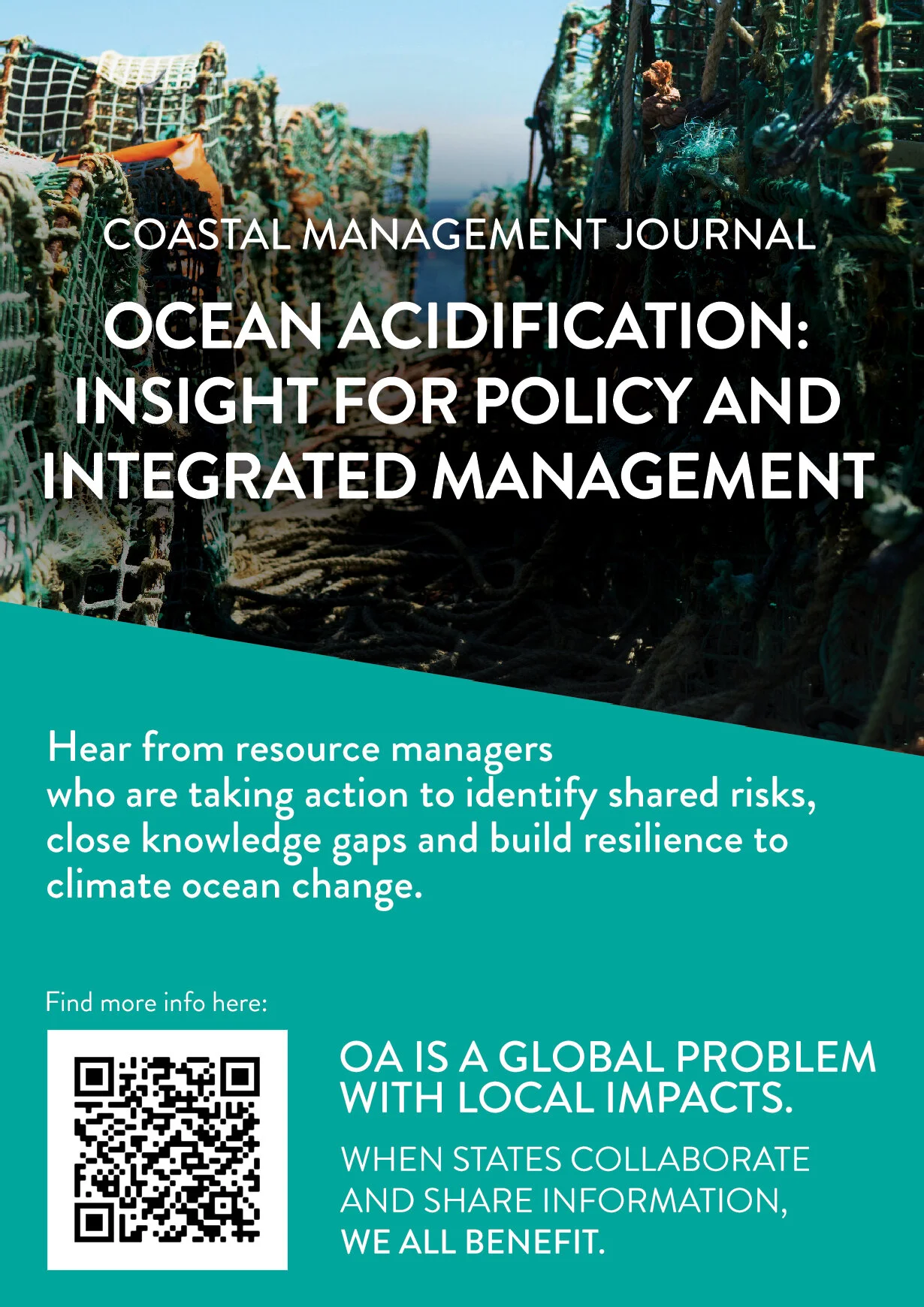
Coastal Management Journal
Ocean Acidification: Insight for Policy and integrated Management
OA is A global problem with local impacts.
When states collaborate and share information, we all benefit.
This special issue examines the challenges and opportunities facing U.S. states in responding to ocean acidification (OA). It includes 42 authors representing government and non-government institutions across nine states.
Many of the authors are resource managers on the front lines of addressing OA and using a variety of strategies to assess information needs, develop data sets, build partnerships inside and outside state government and formulate approaches that link ocean change science to management at local and regional scales.
Although this issue consolidates current and emerging U.S. state policy directives and practices, local and international actors may benefit from lessons learned and case studies presented—further advancing subnational and national efforts to address climate and ocean change.
Guest Editors:
Eric S. Laschever, School of Marine and Environmental Affairs, University of Washington
Jessie Turner, Cascadia Policy Solutions, Secretariat of the International Alliance to Combat Ocean Acidification
Opportunities for state governments and in-region partners to address ocean acidification through management and policy frameworks
Turner et al. (2021) explores the last decade of U.S. state-led action responding to OA, including a 2019 workshop which brought together west coast and east coast states, in addition to participants from Alaska and Hawai’i. The article features lessons learned from the bi-coastal collaboration and illuminates Pathways to Action alongside opportunities for integrating OA actions across existing climate policy and management landscapes.
"Pathways to Action" Process Chart
Understanding and advancing natural resource management in the context of changing ocean conditions
Keil et al. (2021) explores the unique challenge natural resource managers face in preparing for the impacts of changing ocean conditions including ocean acidification, hypoxia, and warming. The article highlights findings of a survey across natural resources managers, which identified OA as a primary concern and is helping to inform important data gaps and priority needs to strengthen decision making at the state level.
Monitoring Ocean Acidification Within State Borders: Lessons Learned from Washington state
Gonski et al. (2021) presents results and recommendations from the first OA monitoring program implemented by a state regulatory agency in the U.S.. Measurements since 2018 reveal differences in OA conditions between areas within Washington State and between seasons. Ultimately, the program aims to detect long-term shifts in marine chemistry driven by carbon emissions, to understand the influence of rivers, and to evaluate the potential of regional actions to mitigate OA. This new monitoring program offers lessons for regulatory agencies responding to OA.
ACCESS THE DATA and READ THE QUALITY ASSURANCE PLAN
Organizing Across Communities of Place, Practice and Governance to Achieve Ocean Acidification and Hypoxia Resilience in Oregon
These case studies illustrate how the State of Oregon has built and sustained momentum using available resources to address capacity gaps. The resulting Oregon OAH Action Plan outlines steps that government, industry, researchers, and individuals can take to learn about, adapt to, and mitigate OAH. Here we identify keys to success thus far and outlines actions of communities of place, practice, and governance that aim to transform resource management and prepare local economies and ecosystems to be more adaptive and resilient to future change.
Learn more about Oregon’s OAH Action Planning
Community science for coastal acidification monitoring and research
A region-wide, simultaneous monitoring event demonstrates opportunities to expand OA research by supporting community-science organizations and fostering private-public partnerships. Such collaboration can help assess local conditions, identify drivers, and inform local adaptation strategies and state policy. The article highlights the role of U.S. Coastal Acidification Networks in promoting stakeholder engagement and coordinated observations, offering a path for governments and resource managers to leverage existing activities.
See “Shell Day” Analysis and Data Set
International and Domestic Leadership by U.S. States on Ocean Acidification
The essay authored by Ocean Conservancy examines U.S. states’ role for increasing climate ambition at domestic and international scales in order to protect ocean resources and coastal communities. State and local actors—given their comparative ability to move quickly and innovate—have advanced climate policy and built support for targeted ocean mitigation, adaptation, and resilience strategies, even when U.S. federal action has stalled.
See State Actions and Investments
taking action to identify shared risks, close knowledge gaps and build RESILIENCE
States are integrating OA responses and responsibilities among applicable departments, actors, and scales. Adaptive management requires a nuanced understanding of ocean and coastal acidification and the relationships—or tradeoffs—between establishing new management tools and leveraging existing programs.
Governments and in-region partners are collaborating to identify and prioritize gaps in knowledge that will inform local intervention strategies and provide managers a more complete picture of local drivers, conditions, vulnerabilities and solutions.
OA conditions in Washington State surface waters across two seasons. Left: November 2018, Right: May 2019.
Red colors are less favorable for shell-building animals, and blue colors are more favorable. (Gonski et al., Figure 1)
Northeast U.S. community science water monitoring stations offer new opportunities to expand OA research. (Gassett et al., Figure 3)
Graph reflects responses from natural resource manager survey participants who indicated the highest level of concern (“very concerned”) for seven changing ocean conditions parameters. (Keil et al., Figure 1)
Infographic shows OA funding investments and policy actions across 23 states. (Berry et al., Figure 1*)
*Data compiled from: https://coast.noaa.gov/digitalcoast/data/enow.html.
Advancing International leadership
Impacts of climate change and increasing OA pose significant risk to states, communities and economies that enjoy and depend on thriving fisheries and shellfish production related to commercial, subsistence or cultural practices.
The Intergovernmental Panel on Climate Change (IPCC) Special Report on Ocean and Cryosphere in Changing Climate (IPCC, 2019) has emphasized that climate change is already having major impacts on our ocean. The report warns that ocean acidification is “virtually certain” to continue to be exacerbated by carbon emissions, with a high emissions path posing the most significant risks for severe and large changes. The Paris Agreement brought into force by the United Nations Framework Convention on Climate Change (UNFCCC) provides a framework for 195 nations to reduce greenhouse gas emissions.
It is against this backdrop that subnational governments, including U.S. states, are sharing information and responding to climate and ocean change by setting ambitious goals and targets of their own to mitigate, adapt and build resiliency.
“lessons learned and partnerships forged at a state level have strengthened regional alignment and international vision for Action.
— Dr. Caren Braby, Oregon Department of Fish and Wildlife
“States have the advantage of being able to act quickly, innovate, and experiment with programs, investments, and pilot projects.
They are typically the primary regulator, or a strong influencer, in implementing most ocean-based climate solutions and responses.”
— Whitney Berry, Senior Manager of Climate Policy, Ocean Conservancy
acknowledgements
Coastal Management journal
Since its founding in 1972 the Coastal Management Journal has led the scholarly exploration of our relationship to coastal areas. This Special Issue’s co-editors, Jessie Turner and Eric Laschever acknowledge the Journal’s leadership and that of the current Journal's Editors, Patrick Christie, David Fluharty, Andrea Copping, and Leif Anderson for recognizing the importance of ocean acidification. Special thanks to Editor in Chief, Patrick Christie; Associate Editor, Andrea Copping; and Assistant to the Editor, Kristina Beverlin for directly supporting this publication. Extra gratitude to those who peer reviewed the manuscripts and contributed to this growing body of work.
Pacific Coast Collaborative
Through the Pacific Coast Collaborative, the province of British Columbia and states of Washington, Oregon, and California share an ambitious goal for reducing greenhouse gas emissions at least 80 percent by 2050 and back up commitments with regional actions to increase resilience to a changing climate.
The PCC OA and Hypoxia Working Group has become a world leader in addressing causes and impacts of climate and ocean change, demonstrating the power of subnational collective action. The working group has been instrumental for linking ocean change science and management at local and regional scales that are most important and achieving healthy and sustainable resources for communities across the Pacific Coast of North America.
University of washington
The University of Washington’s College of the Environment and School of Marine and Environmental Affairs (SMEA) plays a leading role in addressing environmental issues, including acidification.
SMEA has provided expertise on this issue, including through connections made by affiliate faculty member, Eric Laschever, to work being done through the OA Alliance. The OA Alliance has collaborated with SMEA students since 2018 through independent assignments and by supporting a capstone project in 2019-2020 that contributed to the content of this issue. The Program on Climate Change and the Washington Ocean Acidification Center also supported student participation. The SMEA program, College of the Environment, and the University of Washington will continue to be instrumental in responding to climate change's many challenges.
Cascadia Policy Solutions
Pacific Northwest-based Cascadia Policy Solutions supports facilitation of the Pacific Coast Collaborative and is acting Secretariat for the OA Alliance. In her role at Cascadia, Jessie Turner helps set the strategic direction for the OA Alliance, develop annual programming, establish partnerships across a wide variety of disciplines and coalitions, and support its national and subnational government partners in achieving their goals across international platforms and domestic frameworks.
Special Tribute: Benjamin labaree
This special issue of Coastal Management Journal is dedicated to Professor Benjamin Woods Labaree—one of the Sea’s Renaissance Men. The issue documents novel strategies and collaborative efforts at the intersection of science, economics, and policy—the type of intellectual fusion that Professor Labaree exemplifies. Looking back may these efforts mark one step in a renaissance that responds to this challenge.














